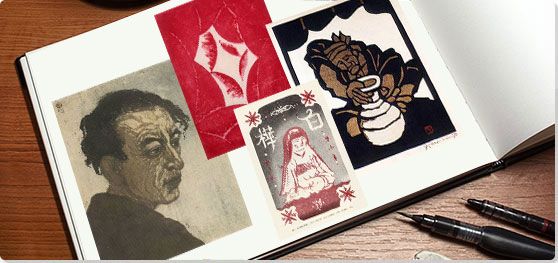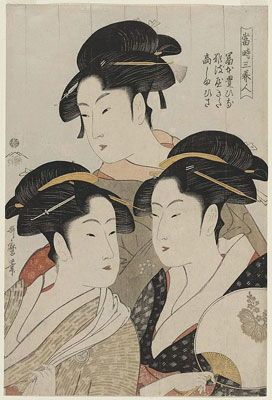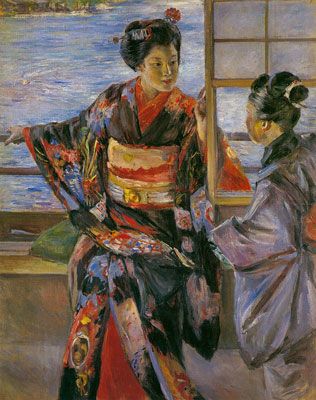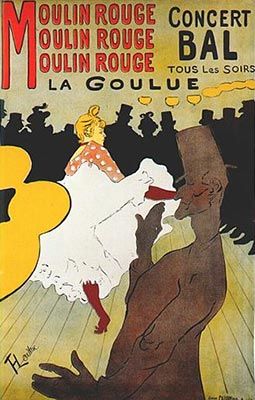Summary of Sōsaku-hanga Creative Prints
Prior to the 20th century, printmaking in Japan had been largely relegated to the commercial process of ukiyo-e woodblocks in which an artist would work with carvers, printers, and publishers to create highly reproducible works of art glamorizing traditional subjects. With the arrival of the Mejii Period in 1868, Japanese artists became exposed to Western influences, spurring the sōsaku-hanga, or "creative prints,' art movement. Prints were transformed from cheap products made for the masses into original works of high art created by an artist that emphasized his or her individual voice and perspective while incorporating modern techniques and styles. Sōsaku-hanga's emergence was concurrent with Yōga, a painting movement also influenced by Western art ideals. The emergence of both, with their impetus toward creative self-expression, was responsible for establishing the new avant-garde in Japan.
Key Ideas & Accomplishments
- In contrast to its sister movement shin-hanga, which was an evolved contemporary form of ukiyo-e, sōsaku-hanga artists were solely involved in the printmaking process from design to finished project. They advocated that art should be self-drawn, self-carved, and self-printed.
- Although many sōsaku-hanga artists departed from historical Japanese art methods and materials through the introduction of perspective or by adopting from Western movements such as Folk Art, Naturalism, Expressionism, or Abstraction, they did so while still paying homage to decidedly Japanese subjects and traditions.
- Sōsaku-hanga's principles contributed to a new intellectual discussion of the "self" that was taking place in the Japanese cultural arena. Its artwork sat side by side with this new discourse in magazines and societies that grew during this time.
- With the rebirth of Japan after World War II, sōsaku-hanga became a strong part of the country's economic reconstruction as American patronage aimed to promote a more Democratic art. Much of the movement's prints at this time became more abstract and were viewed as an authentic blend of East and West.
- Sōsaku-hanga helped elevate the print from a work seen prior as a cheap advertising tool, or lowly form of artistic output for the commoner, to a valid medium for fine art. This elevation made a major contribution to today's proliferation of artist prints as credible forms of high art.
Artworks and Artists of Sōsaku-hanga Creative Prints
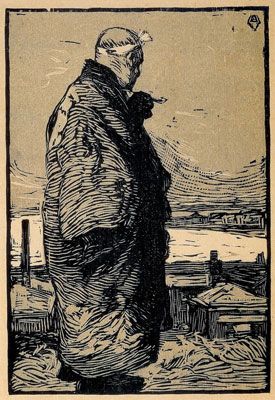
Fisherman
This groundbreaking print shows an aged fisherman, wearing a somewhat worn looking ceremonial robe, as he stands on an elevated spot overlooking the simple huts on the edge of the harbor. The fisherman is seen in profile with his face turned away from the viewer, contemplating the sea as he holds his pipe. The rough gouges of the wood carving create the swirling folds of his robe, the straw pilings on which he stands, the gritty worn feel of the village, and the sea framed by the dark lines of mountains or clouds on the horizon. Retaining the traces left by the chisel, the work is unmistakably modern, in its poignant and expressionistic feeling.
Kanae was originally trained in wood and printing techniques before he began studying Yōga at the Tokyo University of Fine Arts, and this work combines both aspects of his training, as the innovative treatment of the block creates the shadow and depth of a Western-influenced naturalism. The gouges on the surface convey both the harshness and dignity of the fisherman's life.
By eschewing the traditional collaborative process that had been previously established for woodblock prints, and lending the scene a sense of individual artistic expression, this piece launched sôsaku-hanga and also established the movement's divergence from the smoothly finished prints of ukiyo-e and shin-hanga.
Woodblock print - Cleveland Museum of Art, Cleveland, Ohio
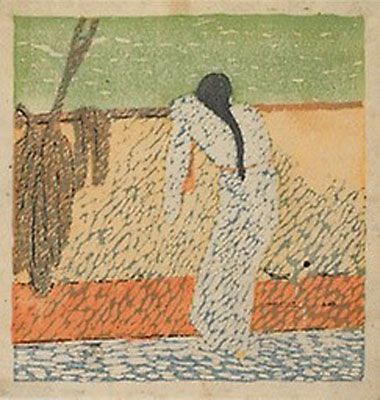
Woman on Deck
This print, depicting the deck of a boat in flat broad planes of orange and yellow with a blue speckled deck, focuses on the stylized figure of a woman, wearing a full length white robe, also flecked with blue, her back turned toward the viewer. The horizontal lines of the background contrast with her curvilinear form, emphasized by the black curve of her hair, and her left, unrealistically accentuated shoulder and arm. A subtle counterpoint of color is created by her orange sash, echoing the color of the lower horizontal band and the right edge of the railing, and by the variations in the blue and white pattern that pools on deck and surrounds her figure like ocean spray.
This work with its color palette and stylized lines brought the influence of Post-Impressionism and Art Nouveau to sōsaku-hanga, while retaining the simplified elements and composition of a Japanese print. The artistic process of carving the woodblock is retained here, giving the work its spontaneous and modern feel, and distinguished sōsaku-hanga's approach from the finished surfaces of both shin-hanga and ukiyo-e.
Color woodblock print - The Art Institute of Chicago, Chicago, Illinois
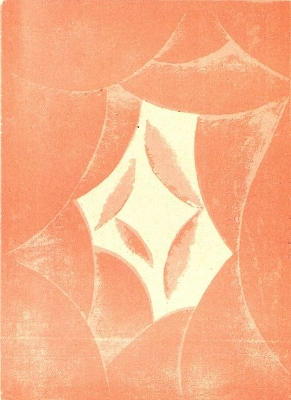
Light Time
This print was groundbreaking in Japan, being the first abstract work, and that firmly connected the sōsaku-hanga movement to the modern avant-garde. This early print combined printing from both carved sides of the block in order to create the unfolding shape, which opens organically from overlying curves of red, outlined in flaring lines of white and red tones. The white shape draws the viewer's eye to the print's center, with its simultaneous organic and geometric vibrancy, highlighted by the four asymmetrical red crescents placed within it.
Onchi's innovative printing process created a composition of multiple prints, overlaying one another, so that multiple perspectives were displayed in a single image. Rather than viewing printing as a reproduction technique to create multiple images of a single block, he focused on the single print as an image composed of multiple blocks or impressions. Even though he was to also create figurative works throughout his career, Onchi said in that abstract art was the "true sphere" of art, and that abstraction was not an imposition of Western influence but a return to the abstract in Japanese art from its ancient beginnings.
Woodblock print - National Museum of Modern Art, Tokyo, Japan
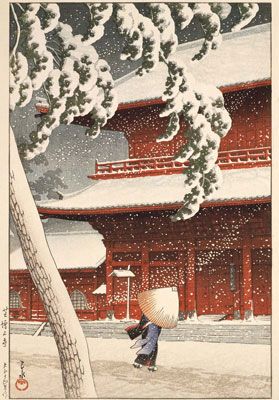
Zôjô-ji Temple in Shiba (Shiba Zôjô-ji)
This shin-hanga print depicts the Shiba Temple in Tokyo on a wintry day. It shows a single figure in the lower center, leaning forward into the blowing snow under a sheltering umbrella. The print focuses primarily on the red temple that fills and overflows the frame, creating a sense of monumental stillness. In contrast, the diagonals of the figure, the tree's trunk on the left, and the windblown snow, create a sense of movement. An evocative and paradoxical feeling of timelessness and the transitory nature of life are conveyed.
This print with its traditional Japanese subject matter and its smoothly finished treatment exemplifies why shin-hanga was also dubbed, "the new ukiyo-e." The work was part of a series Twenty Views of Tokyo (1925), inspired by Hiroshige's One Hundred Famous Views of Edo (1856-1858). Yet Husui's approach is quite different, in both his emphasis upon a solo figure, suggesting the psychological isolation of modern life, and his close cropping of the temple, so that the building, in effect, becomes the landscape. Reflecting the Western influences that distinguished shin-hanga from ukiyo-e, the artist employs perspective, as seen in the vertical and horizontal structure of the building, and depth, as seen in the shadows beneath the overhanging roofs.
The idealized and traditional subject matter, along with the work's polished finish, also sets the work apart from sōsaku-hanga. The work has the idealized, or romanticized feel of most shin-hanga work, creating what has been described, as a "unique and immediate appeal that rests upon traditional virtues of delicacy, poise and restraint." The most popular of the artist's print, this work was reprinted more than 3,000 times. This print, along with its production documentation, was designated an Intangible Cultural Treasure by the Japanese government in 1956.
Woodblock print, ink and color on paper - Museum of Fine Arts, Boston, Massachusetts
Ānanda, Master of Memory and Learning
The novelist Jun'ichirô Tanizaki described Munkata as "an impertinent artist who gouges the universe," and his images have a sculptural power. This woodblock depicts Ānanda, Buddha's cousin and one of his ten disciples, known for his exceptional memory. The name Ānanda means "bliss," reflecting his joyful service to others and exceptional conduct, that spurred the Buddha to praise him for "the purity of his heart." In this image, the artist employed the sumizuri-e, or black ink only, technique to render the figure in bold outlines. The energetic lines convey a sense of spiritual energy, and the figure's outlined head, shoulders, and facial expression create an intensity of gaze, focused on an inner reality.
This print reflects the mingei, or folk art, as well as the Zen Buddhism influences the artist brought to the sōsaku-hanga movement. In the series Ten Great Disciples of Buddha, from which this work is taken, Munakata depicted the ten primary disciples of the Buddha, by using magnolia woodblocks, a hard wood that required carving the figures with a vigorous energy. Munakata felt that the artist was a kind of medium for spiritual reality, and said, "My line must be executed in one quick and spontaneous stroke, as I do not believe in retouching. For the work to be fully animated, one's fresh and raw energy must be shown." To convey the power and expansiveness of the Buddha's message his figure fills up the frame, and the alternating black and white colors express the duality of Yin and Yang, which the figure unifies. Munakata said, "others treat black as black ink...to me it is life itself."
The artist reprinted the series throughout his career, whenever he felt that the times called for the spiritual realities evoked by the figures. As art curator David Libertson said, "These prints spoke both to the fiercely modern nature of Munakata's work and the intertwined history of Buddhism and the woodblock print ... His work is ancient as it is modern. He recognizes a return to ritual, appreciating a power beyond himself that manifests in both his creative process and his completed works."
Woodblock print, ink on paper - The Metropolitan Museum of Art, New York, New York
Stone Buddha at Usuki
This print depicting the ruined Buddhist temple known as the Usuki Site in Öita, Japan, focuses on the head of a Buddha, eyes closed in meditation. Behind the contemplative figure, several bodhisattvas and attending guardians can be seen, while the left lower third of the image is a black and white geometric pattern of broken stones. The diagonals, created by a broken fence-like structure in the center right and a large stone plane, convey a sense of contrast between the ruin of the site on the left and the serenity of the contemplative figures on the right, while the two muscular and fierce guardians in the center exert a protective presence. As a result, the image conveys a powerful sense of eternal calm persisting within temporal ruin.
Hiratsuka's early training was in Yōga painting, but, influenced by Yamamoto Kanae and Hakutei Ishii, he turned to sōsaku-hanga prints and studied with the noted woodblock carver Bonkotsu Igami. As a result he was called "the most professionally trained carver of all the sōsaku-hanga artists." He would become a noted teacher particularly following the publication of his Hanga no giho (Print Techniques) in 1927.
Hiratsuka's work was praised as sculptural, and his unique carving method was tsukibori, or poking strokes, seen in this print particularly in the treatment of the broken rocks. As he said, "This rough line came out of my search for greater strength and a feeling of solid mass." This technique and his subject matter of architectural sites and notable buildings were important contributions to sôsaku-hanga. While Hiratsuka worked in both color and black and white, he became most known for his black and white prints, his primary focus from World War II on. He said that black and white was the "zenith of picture printing," and spoke of it in musical terms, saying, "a black and white must have a rhythm of line and mass and a harmony of straight lines and curves. One of the great difficulties is to make the white space live..." Art historian Helen Merritt has written that his prints are "symbols of a unique symbiosis between the 20th-century art of Japan and that of the West."
Woodblock print - Los Angeles County Museum of Art, Los Angeles, California
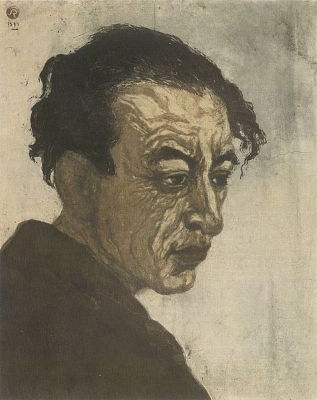
Portrait of Sakutarō Hagiwara
This print shows the poet Sakutarō Hagiwara, viewed in profile, the deep lines in his face and the intensity of his gaze conveying his personality, given to dark introspection. The broad area of flat color in the background sharply outlines his figure and also creates a sense of isolation, as if the poet inhabited his own inner world. Hagiwara has been called "the father of modern colloquial poetry in Japan," as he wrote free verse, disconnecting Japanese poetry from traditional form, to express the anguish and fears of modern existence. Onchi, who was also a noted illustrator, made the frontispiece and several abstract works for Howling at the Moon (1917), Hagiwara's first poetry collection that initiated his fame. The poet described himself as "a half unconscious automatic machine," and the portrait conveys his self-driven intensity.
This portrait established sōsaku-hanga prints as equal in psychological expressiveness to painted modern portraits. As art historian Linda Ganus noted, "Here, the sensitivity of Onchi's draftsmanship and line is captured in the tendrils of the poet's hair and the refined subtlety of his pensive and melancholy gaze; it is remarkably painterly for a woodblock print, as well as a transcendently penetrating and nuanced portrait in any medium." This print became the most popular of Onchi's work, as it was much in demand with American collectors in the post-war era, resulting in numerous reprints. In general Onchi created only one or two prints of each of his blocks, and, even then, would sometimes change some element of the printing, in accordance with his view that each print was a singular work of art, and the printing part of the artistic process, not a mere means of reproduction.
Woodblock print - National Museum of Modern Art, Tokyo, Japan
Lyric No. 6: Solitude
This later abstract print, depicts a number of singular forms overlaying each other: a black spiraling line, a yellowish-brown cloud-like wash, a vertical pillar, an intertwining serpentine line, and a black scribble. It utilizes a subtle but powerful sense of composition to convey the feeling of solitude. Some of the pictorial elements resemble natural forms; the vertical pillar combined with the wash of brown color atop may evoke a tree-like shape while the black spiral might conjure the Fibonacci sequence or a nautilus shell. Yet none of the elements are representational, and the associations they compel remain fluid, suggestive of shifting moods of feeling. The elements feel connected and yet the connection between them remains elusive. As art historian John Fiorillo wrote, "The composition is in flux, intentionally ambiguous, but the impressive control of the print medium and non-traditional print materials argue against chaos. The receptive viewer feels the resonant emotional power of such designs."
This work was part of the artist's Lyric (1949-1951) series, one of many series he was to create referencing music. Onchi felt that what "the heart," or true feeling, could be best expressed artistically when form and color were used not as representational but equivalent to sounds in music. As a result, sōsaku-hanga artists were influenced not only by his abstract treatment, but also by Onchi's emphasis on feeling, as they engaged in their own explorations.
Woodblock print - National Museum of Modern Art, Tokyo, Japan
Object No. 2
This multiblock print shows the orange red imprints of a number of leaves on an irregular grid of varying grey and brown blocks, fit together like a puzzle. The work is abstract, drawing the viewer's attention to the process of creating the print, as the eye is drawn to the grain of the wood, the patterns created by the application of ink, and the veined, irregular, vivid shapes. The brightly pigmented leaf prints associatively evoke organic forms but elude representation. The background with its broad areas of flat color creates elemental geometric forms, and the pictorial space is flattened.
This innovative use of objects as if they were woodblocks, created new artistic possibilities for sōsaku-hanga artists. In his Object (1953-1954) series, Onchi created abstract works using multiblocks, and also employing natural objects - leaves, cardboard, string, fish fins - to create an imprint. Following the difficulties of the World War II era in Japan, driven by an oppressive nationalism that valued only art used for propaganda, Onchi pursued abstraction and a sense of elemental form that he saw as intrinsically Japanese. As art historian Oliver Statler wrote, Onchi's "design, his color, his lyricism, all seem rooted deep in Japan ... Especially Japanese is his passion for fugitive beauty, for the beauty of transient materials, for the fleeting beauty of the moment already gone."
Multiblock print - Honolulu Academy of Art, Honolulu, Hawaii
Four of the Twelve Heavenly Generals
This kappazuri, or stencil print, depicts four of the Twelve Heavenly Generals of Buddhism in a boldly graphic design, their figures created in a geometric pattern. The Heavenly Generals were protective deities, who accompanied the Bhaisajyaguru Buddha, of healing. Bristling with weapons, a bow and arrow, a sword, and staffs, their distinct forms present a unified and interlocking presence as they trample two figures representing illness and suffering underfoot. The fiercely stylized expressions of the figures on the far left and far right are seen in profile, suggesting vigilance. The figure in the center left captures the viewer's gaze with its intensity, its left foot on the head of a fallen enemy conveying a stance of power leaping out from the pictorial space. The overall effect is expressionistic, as the Ronin Gallery has noted, Mori's "art does not quietly wait for its viewer, it shouts out and strikes with awe."
Mori's kappazuri was his primary innovation in the sōsaku-hanga movement, allowing him to make powerful designs, using simplified but charged patterns, as seen here in the curving lines that connect the figures together, contrasted with the verticals and diagonals that convey movement. He began his career as a textile designer, and that early training, along with the influence of mingei, the folk art movement, led him to emphasize bold patterns. In 1962 he was criticized by a leader of the group for having become more of an "artist than an artisan." In the following debate between art and craft, Mori left the mingei movement and focused exclusively on kappazuri works, like this one made the following year. His subject matter, here derived from Buddhist lore, led to his being dubbed the "Child of Edo," for his ability to combine graphic contemporaneity with traditional subjects of the Edo period.
Stencil print (kappazuri); ink on paper laminated with persimmon tannin - The Metropolitan Museum of Art, New York, New York
Beginnings of Sōsaku-hanga Creative Prints
In 1868, the onset of the Mejii Period in Japan brought about new open trade borders with the West, causing a countrywide rush toward modernity that affected all areas of society. Many Western teachers were imported to impart education in science and art in order to elevate Japan as an equal peer with the rest of the world. Many Japanese artists began to shake up what they viewed as the country's staid art traditions by adopting fresh styles and techniques from Western art movements and marrying them with aesthetics that were still decidedly Japanese toward creating a contemporary lexicon.
This caused a large transformation in the printmaking field, which largely consisted of ukiyo-e, an art form that had become noted for cheap reproduction and catering to the masses, disconnected from fine art. Two new strains would emerge.
Also dubbed the "new ukiyo-e," shin-hanga focused primarily on the traditional subjects of ukiyo-e, including kacho-ga, bird and flower prints, bijin-ga, portraits of beautiful women, landscapes of symbolic places in Japan, and kabuki theatre, which had already been well received in the West, launching the 19th century Japonisme movement among artists and designers. At the same time, shin-hanga prints incorporated Western influences, particularly from Impressionism, and were meant to appeal to a Western audience.
Appealing to Western collectors and drawing upon Western influence were shared by both the sōsaku-hanga and shin-hanga movements, but shin-hanga emphasized many reproductions of a single print, and primarily drew upon Western Impressionism, Art Nouveau, and Naturalism to create smoothly finished prints of traditional subjects. In contrast sōsaku-hanga artists favored the avant-garde in both subject matter and technique, argued against reproduction, and created prints that retained the workings of the artistic process.
Yamamoto Kanae
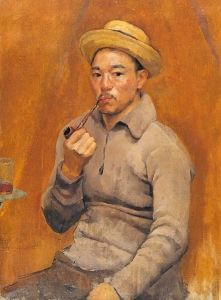
Originally trained as a wood engraver, Yamamoto Kanae began studying Yōga, or Western style painting, at the Tokyo School of Fine Arts in 1902, in part because the influx of Western print technology had made wood engraving an increasingly untenable profession. Studying under Kuroda Seiki, who was considered "the father of modern Japanese western-style painting," he was introduced to a wide range of Western artists and techniques.
In 1904, while still a student, Kanae took a trip to the Chiba Prefecture along the Tone River, where he sketched a fisherman. Returning home he made a woodblock of the sketch, carving one side to be printed in ochre for the broad areas of the image, and the other to be printed in black to create lines and details.
Created by the artist alone, Kanae's Fisherman (1904) was in direct contrast to the popular tradition of shin-hanga, the new woodblock prints of ukiyo-e that had been a collaborative four-step process involving an artist, publisher, woodblock carver, and printer. The resulting print launched the sōsaku-hanga, or creative prints, movement when it was published in Myōjō, a literary and art journal, in 1904. The editor of Myōjō, Hakutei Ishii wrote an accompanying article, calling Fisherman "a revolutionary step" in Japanese art. Ishii would first coin the term sōsaku-hanga in the Bungei hyakka zensho (Encyclopedia of Liberal Arts) (1909).
Sōsaku-hanga sparked new ideas that a work could be driven by an artist's individualism, idealism, and humanism, while still carrying a reverence for traditional Japanese art. It also incorporated an appreciation for Western avant-garde movements and a disregard for reproductive printmaking.
Art curator, Elizabeth Emrich has summarized the difference between the two movements, "While shin-hanga marked both the continuation and transformation of the ukiyo-e tradition during the last years of the Meiji period...the sōsaku-hanga movement, emerging at the same time, drew heavily on Western painting styles within Japan as well as the work of European artists such as Munch, Kandinsky, and Gauguin ... developing new forms of synthesis between modernity and tradition, specifically in the use of Buddhist iconography and calligraphic techniques."
Hakutei Ishii
Hakutei Ishii was also a Yōga painter, who studied with the leaders of the movement, Asai Chū and Kuroda Seiki. Subsequently, he became an active promoter of Western style art in his role as editor of Myōjō (Morning Star) in 1904. With his publication of Kanae's Fisherman, Ishii became a leader of the sōsaku-hanga movement. His close artistic friendship with Kanae led to the two men, along with the artist Tsuruzo Ishii, co-founding Heitan in 1905. The art journal, modeled after European art journals like the Art Nouveau Judgend, published five features of the trio's work along with articles advocating for the new creative possibilities of sōsaku-hanga.
During the Russo-Japanese war of 1904-1905, there was such a demand for prints that more convenient Western printing technologies were widely adopted, and by 1910 the use of woodblocks for commercial printing in Japan had come to an end. In supporting sōsaku-hanga, Ishii was not so much committed to the movement as primarily interested in promoting the continued viability of Japanese prints, as shown in his later return to shin-hanga with his Toyko junikei (Twelve Views of Tokyo), a series he began in 1910.
Shirakaba-ha
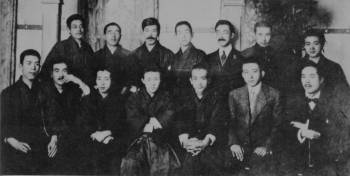
The Shirakaba-ha society, or White Birch Society, played an important role in promoting the individualism of the artist, and in creating an intellectual environment that supported the sōsaku-hanga movement. Created in 1910 by writers, artists, and critics, many of whom had been students at the Gakushin, or Peer's School, in Tokyo, the group included not only noted novelists like Satomi Ton, Takeo Arishima, and Saneatsu Mushanokōji, but the philosopher and later founder of the mingei, or Folk Art movement, Yanagi Sōetsu.
Wanting to counter the naturalism of the previous generation, Shirakaba-ha emphasized positive themes and idealized individualism. As historian Gennifer Weisenfeld noted, "the members...espoused personal cultivation as a legitimate social goal" in all the arts. As shown by their support of the Atarashiki-mura movement, or "New Village," a utopian village where art and ordinary labor were incorporated into daily life, many of them were influenced by the idealized humanism theories of the Russian writer and thinker, Leo Tolstoy.
In 1910 the society launched Shirakaba, or White Birch, which, published until 1923, became the leading journal of the era. The issues combined literary work with art and essays on aesthetics, and played as Weisenfeld wrote, "a major role in introducing and disseminating information about European art." More than eighty works by Paul Cézanne were featured in various issues, as art historian Alicia Volk noted, "More than any artist it was Cézanne who triggered a new way of thinking about art and expression." Japanese artists like the Yōga painter Ryūsei Kishida were associated with the magazine, as shown by his creation of a number of covers for issues from 1918-1922. The artists associated with the journal and the society were particularly influenced by European avant-garde movements and in 1910 began organizing their first exhibition as well as exhibitions of Western art.
Kōtarō Takamura and Natsume Sōseki
Sculptor Kōtarō Takamura and the novelist Natsume Sōseki established the theoretical basis of sōsaku-hanga. Takamura's A Green Sun (1910) emphasized modern artistic freedom, the right to paint the sun green, as he wrote, "I desire absolute freedom of art. Consequently, I recognize the limitless authority of individuality of the artist." Takamura's essay resembled an artistic manifesto, criticizing what he called a "local approach to color," saying, there seem to be some who "think that nature in Japan has a certain inviolable set of colors peculiar to it," and arguing that he'd "like the artist to forget that he's Japanese. I'd like him to rid himself entirely of the idea that he is reproducing nature in Japan. And I'd like him to express on his canvas the tone of nature as he sees it, freely, indulgently, willfully...as Claude Monet did, painting tree leaves sky-blue."
Natsume Sōseki, the novelist described by art historian Kenjiro Okazaki as "the literary giant known to have founded the basis of modern Japanese literature," was deeply interested in art and architecture. His lecture "The Philosophical Basis of the Art of Literature" (1906), which pointed out that an image, apparently before one's eyes, is a composition created by the brain, became an early influence upon the development of Japanese avant-garde art. In his 1912 essay "Bunten and the Creative Arts," he stated that "art begins with the expression of the self and ends with the expression of the self," lending further impetus to sōsaku-hanga concepts of art and individuality. The novelist is still influential today, as evidenced by the creation of an android made to resemble him to give lectures and readings of his works to contemporary audiences in 2016.
Kōshirō Onchi
In 1910 Kōshirō Onchi began studying Yōga painting at the Tokyo School of Fine Arts, where the Western artists Wassily Kandinsky, Edvard Munch, and Paul Cézanne particularly influenced him. However, unhappy with the academic environment, he dropped out after a year and turned to book illustration in 1911, encouraged by Japanese artist and poet Takehisa Yumeiji. Book illustration and design afforded him a livelihood and also informed his interests in poetry, Chinese calligraphy, Western typefaces, and printing techniques.
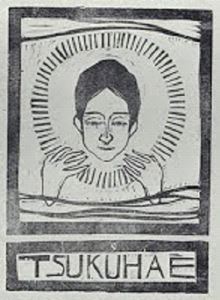
In 1913 Kōshirō Onchi became the leading proponent of sōsaku-hanga, lending his innovative artistic vision and theoretical sense to the movement. His first efforts involved inviting his friends and fellow students at the Tokyo School of Fine Arts, Fujimori Shizuo and Tanaka Kyokichi, to launch a magazine. Tsukuhae, or Moonglow, was launched to publish poetry and prints in 1913. The trio dubbed themselves Bishoha no sanin or Three Men of the Smile School, parodying the various societies of the official art world, and advocating for the avant-garde potential of the self-created print.
From September 1914 to November 1915, Tsukuhae published the sōsaku-hanga prints of the three founding artists along with the Symbolist and Imagist poems of Hakusyū Kitahara, Sakutarō Hagiwara, Saisei Murou, and Bochō Yamaura. The artists intended to create works that, like the poems, expressed thought and feeling in powerful but non-representational images.
Though the magazine was short-lived, Onchi actively created and promoted sōsaku-hanga journals and societies throughout his life. In 1918, along with Yamamoto Kanae and others, he founded the Creative Print Association, which promoted the work of sōsaku-hanga artists in the following decades. In 1928 with Un'ichi Hiratsuka, Sumio Kawakami, Suwa Kanenori, Henmi Takashi, Fujimori Shizuo, Maekawa Senpan, and Fukazawa Sakuichi, he launched a print project One Hundred New Views of Tokyo (1928-1932). In 1939 he founded the Ichimoku-kai, or First Thursday Society, which included artists like Gen Yamaguchi and Jun'ichirô Sekino who met once a month at his home. During the war years, the First Thursday Society supported emerging sōsaku-hanga artists, both financially and artistically, and also established connections with noted American print collectors like William Hartnett. As a result, following World War II the movement continued with renewed vigor, publishing various portfolios of prints, including Tokyo kaiko zue (1945) and Nihon jozoku sen (1946).
Sōsaku-hanga Creative Prints: Concepts, Styles, and Trends
Shin-Hanga and the Overlap with Sōsaku-hanga
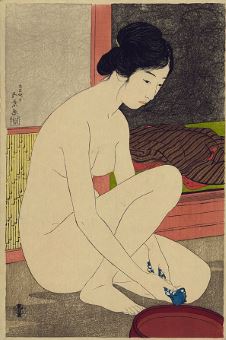
Shin-hanga, or new prints, began under the leadership of Shōzaburō Watanabe, a publisher who wanted to create what he called a "creative new print," who assembled a group of Japanese artists and artisans to fulfill this goal. Goyō Hashiguchi's Woman at Her Bath (1915), made under Watanabe's direction, was the first acclaimed work of the new movement. The work characterized shin-hanga's combination of a traditional Japanese subject in a smoothly finished print while reflecting the Western influence of a naturalistic nude. Another contemporaneous influence upon the development of the movement was the work of Takahashi Hiroaki whose works like Spring Passage (1936) were to have great commercial appeal. From the 1920s until World War I, shin-hanga prints, often romanticized images of Japan, were much sought after abroad, as seen by major exhibitions of shin-hanga works in America in the 1930s.
Among the most noted shin-hanga artists were Hiroshi Yoshida and Kawase Hasui, both particularly known for their landscapes rendered with a kind of painterly naturalism. As art curator Roni Neuer wrote, "Yoshida is, for the early 20th Century, one of the top two artists that did landscape prints. Yoshida and Hasui Kawase revitalized the traditional Japanese landscape print." Hasui portrayed the Japanese landscape and its features and drew upon the ukiyo-e works of Utagawa Hiroshige. Yoshida traveled the world, beginning in the early 1920s, and made prints of the noted landscapes of North America, Europe, North Africa, and Asia, which were globally popular. Yet Yoshida is also an example of the sometimes blurred lines between the shin-hanga and sōsaku-hanga movements, as he is considered to be a leader of the shin-hanga movement, he also created his own printing shop to oversee each step in the process.
Abstraction
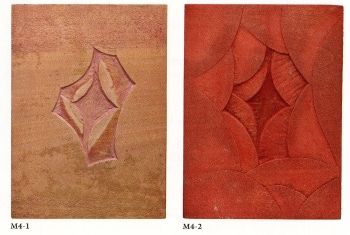
Sōsaku-hanga played a pioneering role in abstraction in Japanese art, particularly through the work of Kōshirō Onchi. His Light Time (1915) is considered to be the first truly abstract Japanese work. However, it was primarily in the late 1930's that abstraction became a leading tendency in sōsaku-hanga, as a new generation of artists like Gen Yamaguchi, Yoshida Masaji, and Shinagawa Takum were influenced by Onchi both in creating abstract works and exploring innovative techniques, as seen in Yamaguichi's Composition (1966). As Masaji wrote, "it was Onchi after the war, who gave me the impetus to do abstract work.... As I listened to him I found that he expressed many ideas I had long felt, and this gave me the confidence I needed."
Mingei
A number of sōsaku-hanga artists became part of the mingei, or the Folk Art movement launched in 1926 by Sōetsu Yanagi, a philosopher and one of the founding members of the Shirakaba-ha society. Yanagi's interest in art began in Korea in 1916 when he began to study and collect folk art objects, particularly ceramics. Yanagi defined mingei as the "hand-crafted art of ordinary people," and his advocacy led to both the creation of the Korean Folk Crafts Museum in 1921 and the Japanese Folk Crafts Museum in 1936. Serizawa Keisuke, a Japanese designer of textiles, became an artistic leader of the movement. He developed the katazome, or stencil dyeing, technique that allowed the inclusion of an uncolored area within a pattern that could then be hand colored, for which he was named in 1956 a Living National Treasure of Japan. He influenced a number of noted artists including Yoshitoshi Mori, Watanabe Sadao, and Shikō Munakata. Mori and Watanabe modified the katazome technique for fabric into the kappazuri, or stencil printing, technique for their sōsaku-hanga work.
Shikō Munakata began his career making sumizuri-e, or black ink only prints, starting in 1926. But his unique contribution to sōsaku-hanga began in 1935 when he met Yanagi Sōetsu, the founder of mingei, and subsequently became associated with the movement. Yanagi Sōetsu felt that mingei reflected the deep values of Japanese art and culture by honoring the medium's materiality with bold and spontaneous expression, devoid of self-consciousness.
Associated with mingei and also a devout Buddhist, Shikō Munakata developed a practice that valued the materiality of the wood that involved carving with spontaneous boldness, usually without preliminary sketches. As he said, "The mind goes and the tool walks alone." In contrast to Onchi who felt sōsaku-hanga was an expression of the self; Munakata felt that art was an expression of nature's reality and beauty, residing in the woodblock itself. He said, "the essence of hanga lies in the fact that one must give in to the ways of the board ... there is a power in the board, and one cannot force the tool against that power." His Ten Great Disciples of the Buddha (1939), a series of black and white prints carved out of magnolia blocks, exemplified his approach.
Later Developments - After Sōsaku-hanga Creative Prints
By the 1960's sōsaku-hanga as a vital movement had declined, in part due to the deaths of noted leaders like Onchi, but also due to the development of new international movements like Fluxus, the Gutai movement, and the new Japanese avant-garde. The printmaking that followed often explored Western techniques or combined that influence with both shin-hanga and sōsaku-hanga approaches.
Sōsaku-hanga's emphasis on avant-garde work and the exploration of technique was a primary influence on kindai hanga, modern or contemporary prints. The use of mixed media and innovative printing techniques by artists like Onchi and Munakata encouraged an attitude of openness to Western printing techniques as seen in the silk screening work of later Japanese artists like Sekine Yoshio, and Sawada Tetsurô. Onchi's exploration of photography influenced Taniguchi Shigeru, and, at the same time, his exploration of mixed media influenced later artists like Tetsuya Noda. Amano Kazumi in the 1960s was strongly inspired by his teacher Munakata Shikô. In the 1980s, both Hamaguchi Yozo and Hamanishi Katsunori drew upon sōsaku-hanga in making their mezzotint prints. The Scottish artist Paul Binnie and the Canadian David Bull have combined the influence of both shin-hanga and sōsaku-hanga in their work, as seen in Binnie's focus upon kabuki characters derived from ukiyo-e.
Sōsaku-hanga also influenced artists like Saburō Hasegawa, part of the Gutai movement and colleague of John Cage, in the development of what he called his "Multi-Block" prints, where he would randomly place carved blocks to create varying pictorial surfaces, or what he called "environments." Some scholars feel that Cage's use of graphic notation was influenced and inspired by Hasegawa's multi-blocks.
Of the individual artists who were part of the sôsaku-hanga movement, the most influential was Kôshirô Onchi, as he influenced several generations of artists, including Un'ichi Hiratsuka, Jun'ichiro Sekino, Gen Yamaguchi, Rikio Takahashi, Haku Maki, and Masaj Yoshida. As the artist Yamaguichi Gen said of the artist after his death, "Onchi was a vital artist...He was the embodiment of modern hanga in Japan and our ambassador to the rest of the world."
Useful Resources on Sōsaku-hanga Creative Prints
- Koshiro Onchi, 1891-1955: WoodcutsBy Koshiro Onchi
- Onchi Koshiro: The National Museum of Modern Art, Tokyo, January 13 - February 28, 2016By Tohru Matusmoto and Koshiro Onchi, et al.
- Hanga: Japanese Creative PrintsBy Chiaki Ajioka, Noriko Kuwahara, and Junko Nishiyama
- Japan's modern prints - Sosaku HangaOur PickBy Oliver Statler and Margaret Gentles
